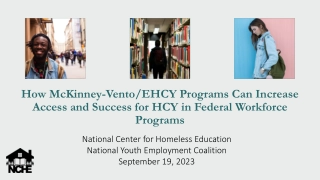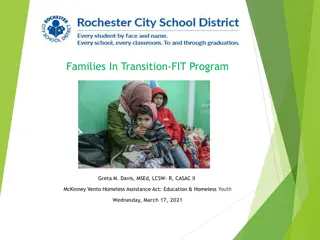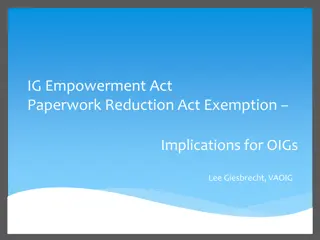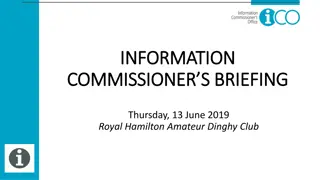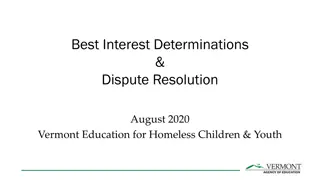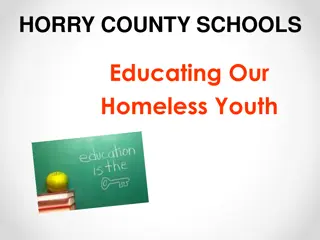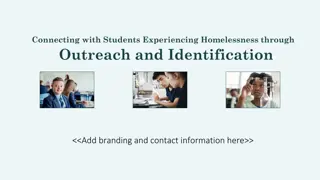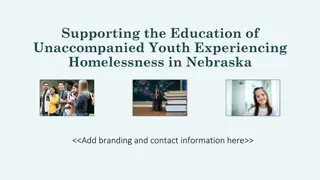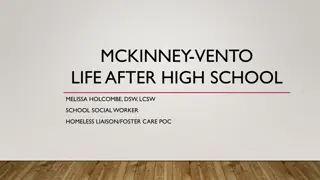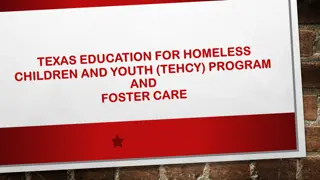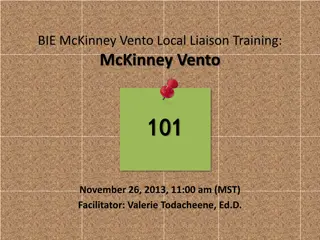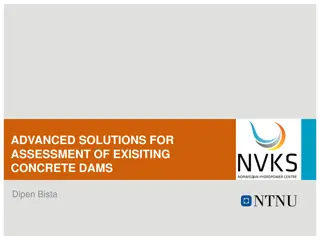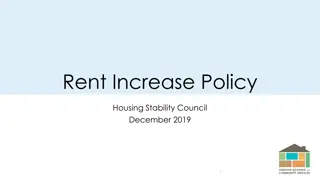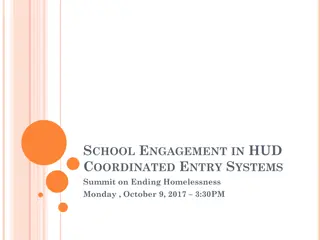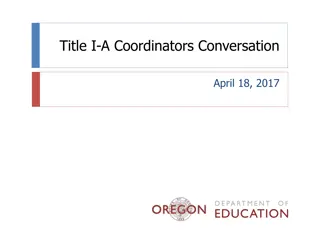Understanding the McKinney-Vento Act: School Access and Stability
Exploring the McKinney-Vento Act and its impact on ensuring educational access, stability, and support for homeless children and youth. Learn about the roles of local liaisons, student eligibility, enrollment, transportation, and dispute resolution under the Act.
Download Presentation

Please find below an Image/Link to download the presentation.
The content on the website is provided AS IS for your information and personal use only. It may not be sold, licensed, or shared on other websites without obtaining consent from the author. Download presentation by click this link. If you encounter any issues during the download, it is possible that the publisher has removed the file from their server.
E N D
Presentation Transcript
McKinney-Vento 101: School Access and Stability under the McKinney-Vento Act National Center for Homeless Education (NCHE) (800) 308-2145 homeless@serve.org
Get to Know NCHE NCHE operates the U.S. Department of Education s homeless education technical assistance and information center Website: www.serve.org/nche Webinars: www.serve.org/nche/web/group.php Helpline: 800-308-2145 or homeless@serve.org Listserv: www.serve.org/nche/listserv.php Products: www.serve.org/nche/products.php Handouts: www.serve.org/nche/web/mv102- part2.php
Additional Information Feature Additional information in the slide notes area
Todays Goals Become familiar with important McKinney- Vento Act concepts, including: The role of the local liaison Student eligibility School selection Enrollment Transportation Dispute resolution Engage in discussion and Q&A
The McKinney-Vento Act Subtitle VII-B of the McKinney-Vento Homeless Assistance Act (42 U.S.C. 11431 et seq.) Reauthorized in 2001 by Title X, Part C of the No Child Left Behind Act Establishes the definition of homeless used by schools Ensures that children and youth experiencing homelessness have immediate and equal access to public education Provides for educational access, stability, and support to promote school success Needed to address the unique barriers faced by many homeless students
Local Liaisons Every school district must designate an appropriate staff person to serve as the local homeless education liaison; may be the coordinator for other federal programs Local liaisons serve as the key homeless education contact for the school district Local liaisons play a critical role in the implementation of the McKinney-Vento Act
Local Liaison Responsibilities Identifying homeless children and youth Ensuring that homeless students can enroll immediately and participate fully in school Informing parents, guardians, and youth of educational rights Ensuring the public posting of educational rights throughout the school district and community
Local Liaison Responsibilities (pt. 2) Ensuring that disputes are resolved promptly Supporting unaccompanied homeless youth in school selection and dispute resolution Collaborating with other district programs and community agencies Linking homeless students with other services, as needed
McKinney-Vento Eligibility Children or youth who lack a fixed, regular, and adequate nighttime residence, including: Sharing the housing of other persons due to loss of housing, economic hardship, or a similar reason Living in motels, hotels, trailer parks, or camping grounds due to the lack of alternative adequate accommodations Living in emergency or transitional shelters
McKinney-Vento Eligibility (pt. 2) Awaiting foster care placement Living in a public or private place not designed for or ordinarily used as a regular sleeping accommodation for human beings Living in cars, parks, public spaces, abandoned buildings, substandard housing, bus or train stations, or similar settings Migratory children living in the above circumstances Unaccompanied youth living in the above circumstances
Fixed, Regular, and Adequate Fixed: Stationary, permanent, not subject to change Regular: Used on a predictable, routine, consistent basis Consider the relative permanence Adequate: Lawfully and reasonably sufficient Sufficient for meeting the physical and psychological needs typically met in a home environment Can the student go to the SAME PLACE (fixed) EVERY NIGHT (regular) to sleep in a SAFE AND SUFFICIENT SPACE (adequate)?
Shared Housing Legislative wording: sharing the housing of other persons due to loss of housing, economic hardship, or a similar reason Considerations: Why did the parties move in together? Due to a crisis or by mutual choice as a plan for mutual benefit? How permanent is the living arrangement intended to be? Where would the party in crisis live if not sharing housing? Is the living arrangement fixed, regular, and adequate?
Important Eligibility Considerations Reference legislative wording Make determinations on a case-by-case basis based on the circumstances of each child Understand that some cases will be clear-cut; others will require further inquiry and a more nuanced analysis Use fixed, regular, and adequate as guiding principles Remember that the list of living arrangements included in the law describes common homeless situations, but is not exhaustive
School Selection Students experiencing homelessness may attend either: The local attendance area school: Any public school that students living in the same attendance area are eligible to attend The school of origin: The school the child or youth attended when permanently housed; or The school in which the child or youth was last enrolled
School Selection Best interest: Keep homeless students in their schools of origin, to the extent feasible, unless this is against the parent s or guardian s wishes A school selection decision must occur; ideally, the parents/guardians/youth and school agree; if not, the dispute resolution process may be used
Feasibility Considerations: The age of the child or youth The distance of a commute and the impact it may have on the student s education Personal safety issues A student s need for special instruction (e.g., special education and related services) The length of anticipated stay in a temporary shelter or other temporary location The time remaining in the school year Question G-4, U.S. Department of Education Guidance (www.ed.gov/programs/homeless/guidance.pdf)
Feasibility The placement determination should be a student-centered, individualized determination There is no time or distance limit placed on school of origin transportation; consider the unique situation of the student and how the transportation will affect the student s education
School Selection Students may continue attending the school of origin the entire time they are homeless, and until the end of any school year in which they move into permanent housing Students who become homeless in between school years may continue attending the school of origin for the following school year
Enrollment States and districts must develop, review, and revise policies to remove barriers to the school enrollment and retention of homeless children and youth McKinney-Vento defines enrollment as attending classes and participating fully in school activities The McKinney-Vento Act (federal law) supersedes state or local law or policy when there is a conflict (U.S. Constitution, Article VI)
Enrollment Homeless children and youth have the right to enroll in school immediately, even if lacking documentation normally required for enrollment If a child or youth needs to obtain immunizations, or immunization or medical records, the enrolling school must refer the parent or guardian immediately to the local liaison, who must assist in obtaining necessary immunizations, or immunization or medical records; the school must continue the child s enrollment in the meantime
Transportation School districts must provide the following transportation for McKinney-Vento students: Transportation to and from the school of origin Comparable transportation Based on the best interest of the student and in consultation with the parent, the district ultimately determines the mode of transportation.
School of Origin Transportation Districts must transport homeless students to and from the school of origin, at a parent s or guardian s request, or at the local liaison s request for unaccompanied homeless youth If the child or youth lives and attends school within the same district, that district must provide or arrange transportation If the child or youth lives and attends in different districts, the districts must agree on how to split the responsibility and cost of transportation or share them equally
Transportation Districts should use a team approach in developing transportation policies and procedures; the team should include the transportation director, local liaison, neighboring school districts, and service providers, as appropriate Districts may consider other safe transportation options besides school busses, in keeping with state and local pupil transportation guidelines Consult with pupil transportation directors about transportation options
Dispute Resolution States must establish a process for the prompt resolution of enrollment or school selection disputes If a disagreement occurs, the district must: Provide a written explanation of its decision, including the right to appeal the decision Refer the parent/guardian/youth to the local liaison, who will carry out the dispute resolution process as expeditiously as possible Unaccompanied homeless youth have the same right to dispute as parents/guardians
Dispute Resolution While the dispute is in process, students must be: Enrolled immediately in the school in which enrollment is sought Provided with school of origin transportation, if requested Provided with all services for which they are eligible
Dispute Resolution Districts should familiarize themselves with their state s McKinney-Vento dispute policy, as it may include important details about how disputes are mediated within the state Documentation should be kept for all local liaison interventions, not just formal disputes
NCHE Homeless Liaison Toolkit Comprehensive resource that will assist both new and veteran local liaisons Draws on the expertise of experienced practitioners Includes requirements of the law, good practices, sample forms, and links to resources Visit (www.serve.org/nche/pr/liaison_toolkit. php)


